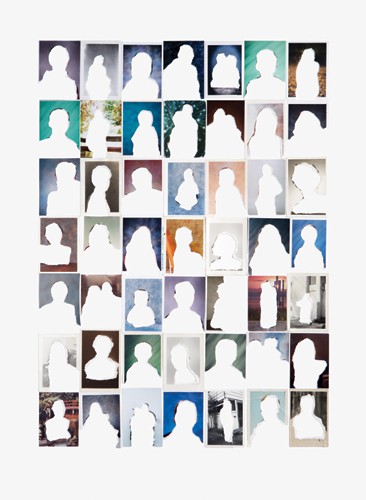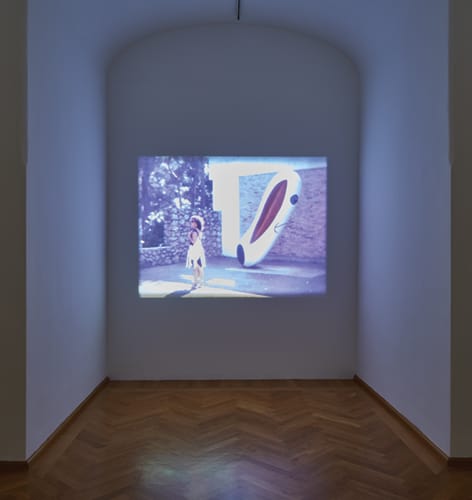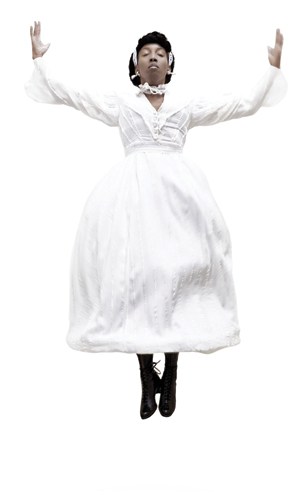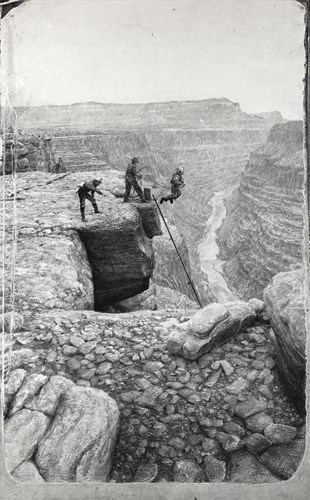
“Portrait (Background),” 2016, Joe Rudko, Cut found photographs on paper, 30″ x 22″ Photo: courtesy Greg Kucera Gallery
Joe Rudko reassembles other people’s memories in his solo exhibition, “Basic Techniques of Photography.” The Seattle artist’s earlier Object Drawings series merged photographs and postcards with pencil and ink drawings that reenvisioned the original objects as stretched, digital-like forms. One of these famously landed on the cover of Seattle band Death Cab for Cutie’s 2015 album Kintsugi. Exploring the tension between past and future media, Object Drawings appear again in Rudko’s new exhibit, but they are coupled with refined collages created from found photographs the artist cuts, folds and tears. A striking sense of intimacy permeates the experience of visually riffling through these shards of others’ lives. Studio Portrait (2017) combines uniform squares of eyelids, grins, and V-neck sweaters into a form that becomes a single visage when viewed at a distance. Gazing into the fragmented facial features feels like examining the people they belong to under a microscope. Yet, the assemblage makes it difficult for the eye to distinguish between individuals, evoking questions of how misleading constructed intimacy can be. “Basic Techniques of Photography” remains on view at Greg Kucera Gallery through May 27, 2017.
Photo: courtesy Season
New York artist Sharon Butler’s “Good Morning Drawings” play with expectations of painting’s role to the digital world. Pushing past the oft-revisited inquiry into the medium’s pending death, the ten works on view at Season instead bring out the question’s absurdity. Reversing the typical process of photographing paintings for sharing in the digital realm, Butler first created the series of line-based, abstract works on iPad, and posted them to Instagram as part of a daily routine, only later translating them into oil paintings. Citing “the common artists’ practice of showing images of paintings to one another by phone,” as the project’s starting point, Butler’s gesture nods towards the social exchange that’s been integral to painting throughout history. More surprising is the ease with which the work moves between mediums. The online iterations pop with high contrasts and assertive lines, while the paintings incorporate soft movements and textures, achieving their volume through a scale that feels grand against the confines of digital screens. Stack (2016) integrates several of the Instagram images into a single composition whose visible layers make a case for keeping the past and present in active dialogue. “Good Morning Drawings” is on view at Season through June 30, 2017.
Courtesy: the artist and Simon Preston Gallery, New York.
Christie’s auction house, Le Corbusier’s Villa Savoye, furniture collectors’ homes, and the Freud Museum mark key sites for Amie Siegel’s video works in her solo exhibition “Interiors.” Experiencing the New York artist’s work that examines cycles of ownership, spectatorship, and economics in the context of the Frye Art Museum, beside the founders’ idiosyncratic art collection that is consistently on view, is especially poignant. Provenance (2013), one of Siegel’s most recognized films, documents a furniture collection designed by Le Corbusier for a planned city in Chandigarh, India. Telling the story in reverse chronology, Siegel’s montages begin in the collectors’ homes where the furniture currently resides, before moving back through the auction houses and restoration stops it made during its global journey. Also included in the show, Fetish (2016) portrays the cleaning process of archaeological objects which once belonged to Sigmund Freud but are now housed in a London Museum devoted to the psychoanalyst. Experiencing this process within the walls of an institution that began from the Fryes’ own object obsessions is a unique opportunity to consider Siegel’s work while physically inside the kind of institution her work dissects. “Interiors” runs May 20 – September 3, 2017 at the Frye Art Museum.
Photo: courtesy Linda Hodges Gallery
Polina Tereshina’s art resists boundaries in subject, form, medium, or otherwise. The Russian-born artist’s first major solo show in Seattle includes new iterations of the cartoonish figures that move between genders, which were seen in her earlier work. In one of Tereshina’s gouache paintings rendered in her typically bright pastels, the modest globes of her subject’s breasts are paired are with stick-straight hips that don tighty-whities. In another, a reimagined reclining figure sprawls across a coffee table in an undershirt, its face hidden behind a thick mass of brown hair but with nails and toes noticeably painted. The work physically moves beyond the confines of its own frames, through affiliated sculptures affixed to the walls that expand the paintings into three-dimensional, abstracted forms. While the accessories and objects that often appear with Tereshina’s figures lend a tone of humor to her work, their faces’ expressions (or lack thereof) keep the images from becoming too buoyant. By maintaining this foundation of seriousness throughout her work, the artist pushes her viewers to give thoughtful consideration to the arbitrariness of boundaries. “Polina Tereshina” runs May 4 – 27, 2017 at Linda Hodges Gallery.
51″ x 30″ Photo: courtesy Ibrahim Gallery
Ayana V. Jackson’s series “Dear Sarah” seems straightforward, at first. Five of the photographs show the New York artist wearing a bell-shaped, white dress that evokes an earlier time. Yet a confounding factor appears on the show’s periphery: a small, archival image of Sarah Forbes Bonetta Davies on her wedding day, in 1862. Jackson has a history of integrating archival content in her work. In “Dear Sarah,” she uses self-portraits to perform as the African woman of Yoruba origin who was presented to Queen Victoria as a gift. In Jackson’s visual interpretations of her story, Davies embodies a quiet sense of strength. Each portrayal keeps her internal consciousness too distant for a viewer to grasp. Yet subtle gestures—a light smile, extended palms, an uplifted stance—allude to her complex inner life. In the most memorable image of the series, Jackson dresses in ornate, royal blue garments and confronts the camera directly, displaying a sense of control and esteem. While a complete history of Davies’ life is unlikely to emerge, Jackson’s series makes the case to reconsider history’s unseen figures and the need for their more complete understanding. “Dear Sarah” remains on view at Mariane Ibrahim Gallery through May 20, 2017.
graphite on paper, 74″ x 46″
Photo: courtesy Winston Wächter Fine Art
“Time to ride out of town on my hobby horse with my authentic dungarees and plastic cowboy hat. Catch you on the other side of that Mesa backdrop,” writes Ethan Murrow, in a statement on his new show, “The Cowboy.” The Boston artist’s latest series of graphite drawings explore the American West through renderings that fuse detailed landscapes, cultural icons, and surreal objects in a way that questions the line between fiction and reality. Murrow’s statement on the show speaks to compelling elements of the narratives that emerge as he situates romanticized notions of the West within his characteristically absurd scenes. Cutting the Waddle Of The Pyrite (2016) shows a man who appears part-rancher, part-Indiana-Jones, as he pulls a Jenga-like wood block from beneath a cactus. As is the case in most of Murrow’s work, delving more deeply into the image’s details only brings forth more questions. But in a time when questioning information and news sources has become a daily routine, and the truth and the absurd seem particularly interchangeable, getting lost in Murrow’s worlds is a welcome and resonant respite. “The Cowboy” can be viewed at Winston Wächter Fine Art through June 20, 2017.




